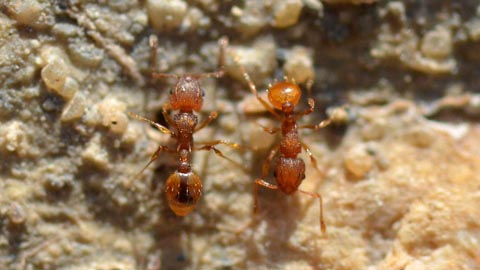Fire ant reaches the Iberian Peninsula

26/11/2018
The electric ant, also known as the little fire ant, has been located in an established and expanding population which occupies some 6 hectares of a residential neighbourhood in Marbella. This particular ant species received the name of "little fire ant" due to its painful sting. Although it poses no threat to humans, in both in its native range (area between Brazil, Argentina and Uruguay) and in places in which it has become an invasive species there have been cases of wild and domesticated animals being blinded by an ant's sting to the eyes, including cats, chicken, jaguars and even African elephants. The scientific article describing the discovery included the involvement of UAB and CREAF researcher Xavier Espadaler and has already been shared with the Marbella City Council, which has not yet responded to the communication.
The call from a pest control company worker alerted of the existence of ants that were "very small and bite" and this permitted researchers to find the little fire ants in the crack of a wall of a residential neighbourhood of Marbella. “According to the principle of precaution, we believe they must be eradicated. This would be possible if they occupy a space smaller than 10ha, but larger areas would make it impossible”, Espadaler explains. Nevertheless, he alerts that this probably is not the only colony existing in the area. “The ant is so small it is practically undetectable, you must know its location and look carefully for it, otherwise it is impossible to see a light brown ant measuring a bit over 1mm. It is possible for them to have gone to other parts and no one has seen them yet”, he adds.
The little fire ant lives in warm and humid climates and on this map it can be seen that it has already invaded tropical areas in Africa, the Caribbean and the Pacific, as well as the north-eastern part of Australia, particularly in coffee and cocoa monocultures. The population found in Marbella, together with those existing in Israel, are the most northern populations to have been found in Europe and the Middle East, where little fire ant colonies have been found to live in well-irrigated areas, such as gardens and private backyards. “The fact that the south of Spain being so urbanised and the high temperatures make it easy for this ant to spread to other regions, there is no doubt about that. Treatments are needed to eradicate this population and gardens will not be able to be watered for two years”, Espadaler states.
In addition to representing a high health risk due to the fact that its bite can leave animals blind (no cases of human blindness have been detected until now), ecologically they can also pose a severe problem, as the invasive Argentinian ant has already done. Scientists did not detect any other ant species within the urbanised area in which the little fire ant was found. Xavier Espadaler explains that “they do not directly attack other ants. It is simply a question of numbers. There are so many fire ants in a colony, many more than in other species, that they find food first. This is known as the competitive exclusion principle”.
Original article: Espadaler X., Pradera C., Santana J.A. (2018). The first outdoor-nesting population of Wasmannia auropunctata in continental Europe (Hymenoptera, Formicidae). Iberomyrmex, nº 10. Artículos y notes.